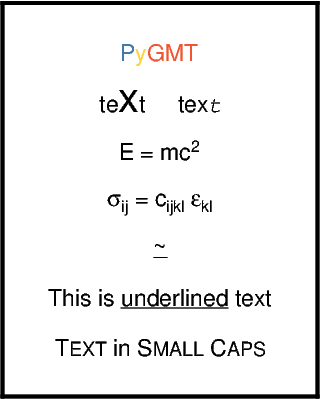Note
Go to the end to download the full example code.
Text formatting
There are various options for formatting text contained in a plot, e.g., text added via
pygmt.Figure.text, the plot title, labels of colorbars as well as Cartesian
axes, and legend entries. It’s also possible to change the font as well as its color
and size only for specific characters of a longer text. The supported fonts are listed
at Supported Fonts. For an complete overview see
Text Formatting.

import pygmt
fig = pygmt.Figure()
fig.basemap(region=[-1, 1, -4, 4], projection="X4c/5c", frame=0)
# Change font color for specific letters of the word "PyGMT":
# blue for "P", yellow for "y", and red for "GMT"
fig.text(x=0, y=3, text="@;63/124/173;P@;;@;255/212/59;y@;;@;238/86/52;GMT@;;")
# Change font size and style for one single character, respectively
fig.text(x=0, y=2, text="te@:15:x@::t tex@%Courier-Oblique%t@%%")
# Use superscript
fig.text(x=0, y=1, text="E = mc@+2@+")
# Use subscripts and Greek letters
fig.text(x=0, y=0, text="@~s@~@-ij@- = c@-ijkl@- @~e@~@-kl@-")
# Combine two characters above each other
fig.text(x=0, y=-1, text="@!_~")
# Underline the text
fig.text(x=0, y=-2, text="This is @_underlined@_ text")
# Use small caps
fig.text(x=0, y=-3, text="T@#ext@# in S@#mall@# C@#aps@#")
fig.show()
Total running time of the script: (0 minutes 0.131 seconds)